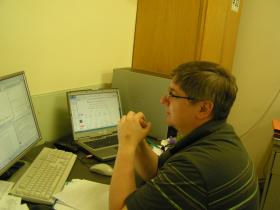An International group of scientists including SINP researchers measured characteristics of the decay of baryons with heavy quarks on the ATLAS detector in order to study baryonic asymmetry. The report is published on arxiv.org.
The Head of the SINP Laboratory of High Energies, DSc. Leonid Gladilin told us about this study and a heart of the problem of baryonic asymmetry.
- Leonid, please, tell us about yout research.
- It is known that dissymetry of baryons and antibaryons is broken, i.e. parity failure takes place. In order to find out the parameters of parity failure we measured characteristics of Λb-baryon decay in details - it is an analogous of proton, but with b-quark instead of one u-quark.
- What access does this study give?
- I suppose, that this study gives us an access to the better understanding of baryons configuration, life and decay. It is very important for more detailed theoretical predictions.
Then, such measurements can help us to understand: why are we surrounded with matter and baryons, while there are none anti-matter and anti-baryons, or little? Measuring baryons decay in details, we try to understand: what is the difference between baryons and anti-baryons? At the same time we must understand: why is there an asymmetry of matter and anti-matter in the Universe?
- Who conducted the studies?
- The research was carried out by a group of B-physics of ATLAS collaboration, which consisted of about ten scientists from different countries. SINP researchers took part in the studies on the Russian side. It is a result of cooperation of a huge collaboration (about 3 thousands people). Previously the analogous results were published by the LHCb collaboration. We have started our studies simultaneously, but they have published the results earlier than we. These two papers together provide a good concept of baryonic decay characteristics and about their correspondence to theory.
- Have you compared the results of two researches?
- Our experimental results were compared to the experimental results of the LHCb collaboration, and good agreement was found. Experimental results were also compared to the theoretical predictions - agreement is not so good. The most likely reason is that detailed experimental results are absolutely new, and theorists have not calculate them.
- Please, tell us about the mechanism of baryonic decay.
- We used decay of Λb-baryon, which is known for about 15 years. During this decay Λb-baryon transforms into J/ψ-particle and regular Λ0-baryon. Then J/ψ-particles decays into positive and negative muons (µ+, µ-), and Λ0-baryon decays into proton and pion. We measured the escape angles of two muons, proton and pion and calculated amplitudes, which influence baryonic decay.
- Have you found out why and how dissymetry of baryons and antibaryons is broken?
- Within the frames of this study we have measured the value of symmetry failure parameter for the certain decay. The phenomenon of symmetry failure itself is considered as a property of weak interactions, i.e. of the processes of heavy W and Z bozons exchange.

